
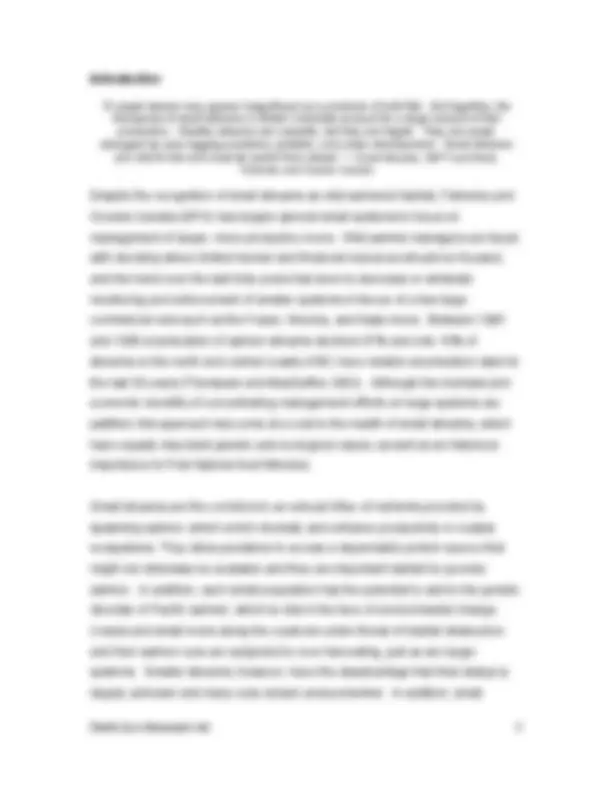
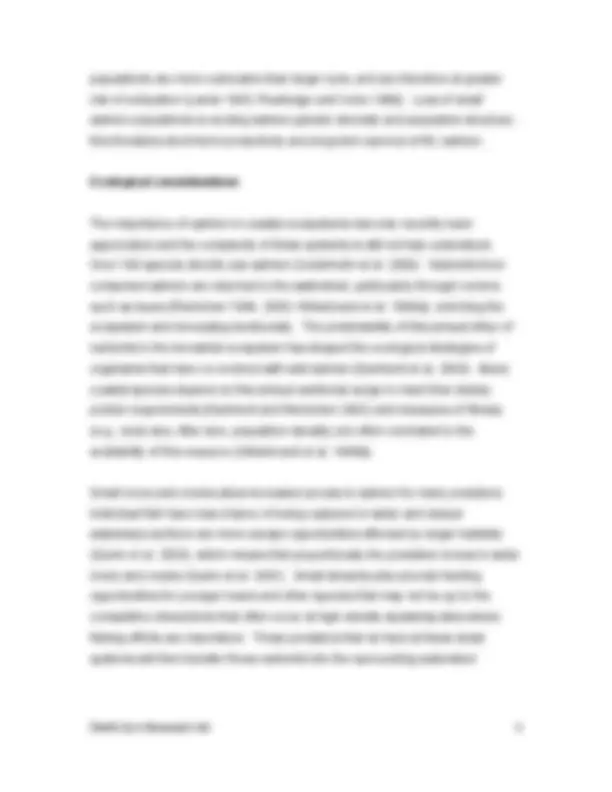
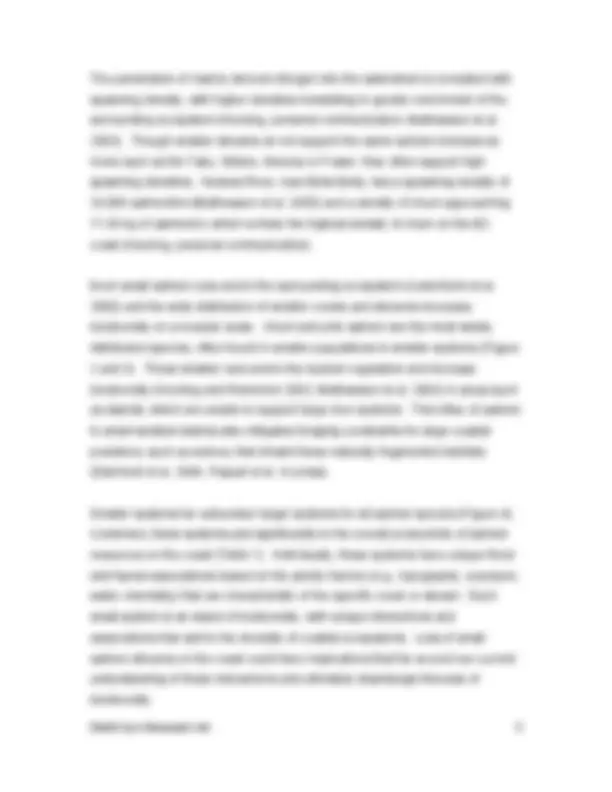
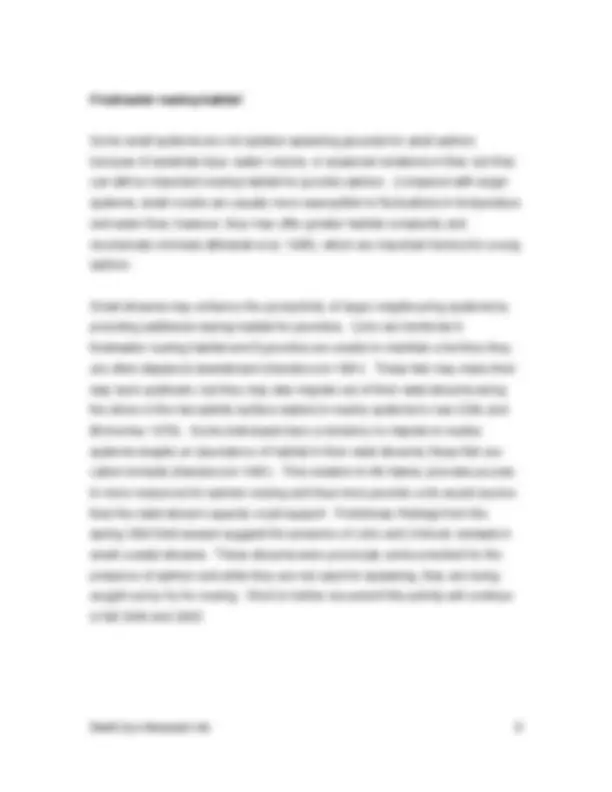
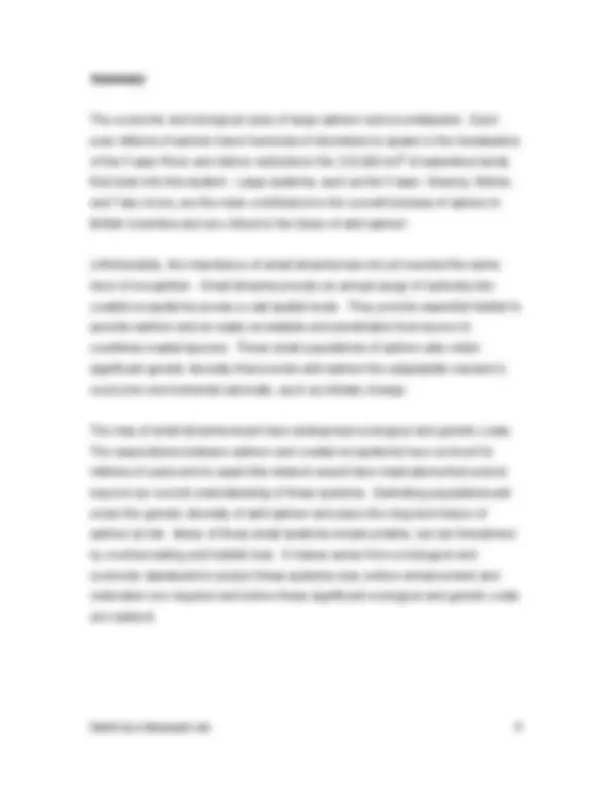
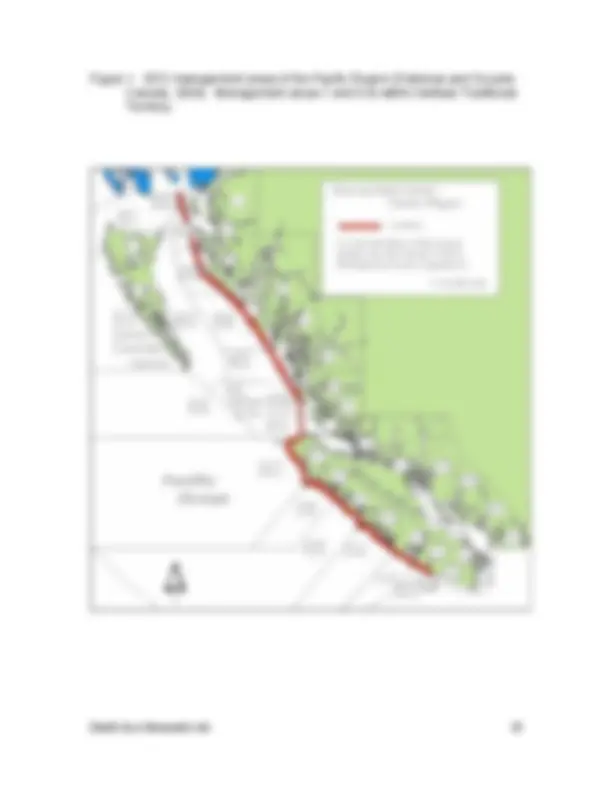
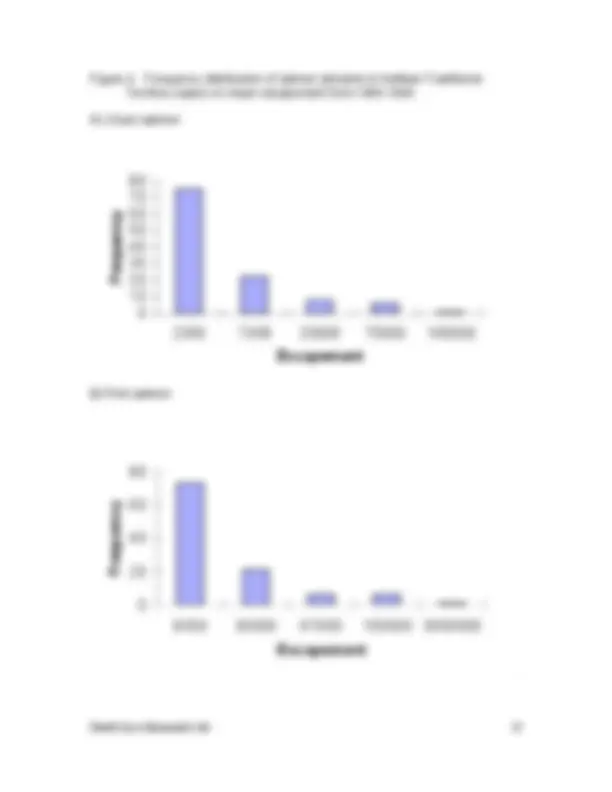
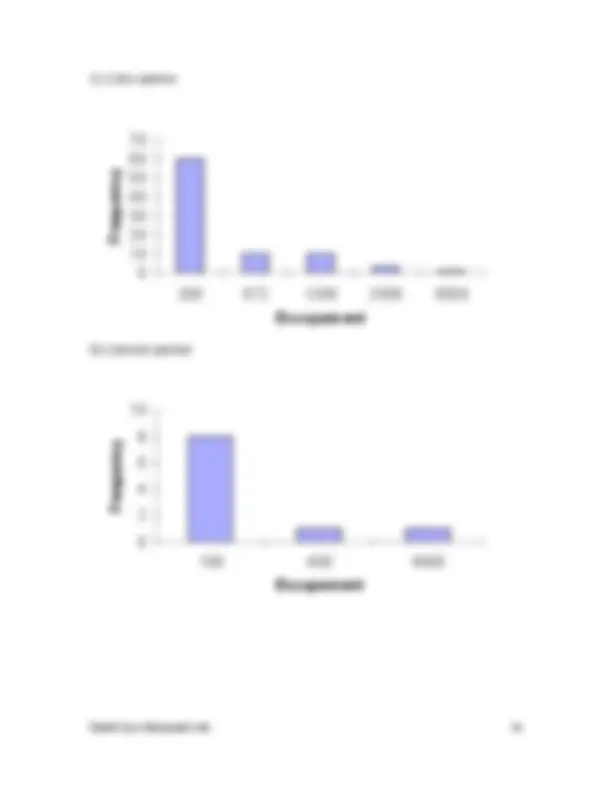
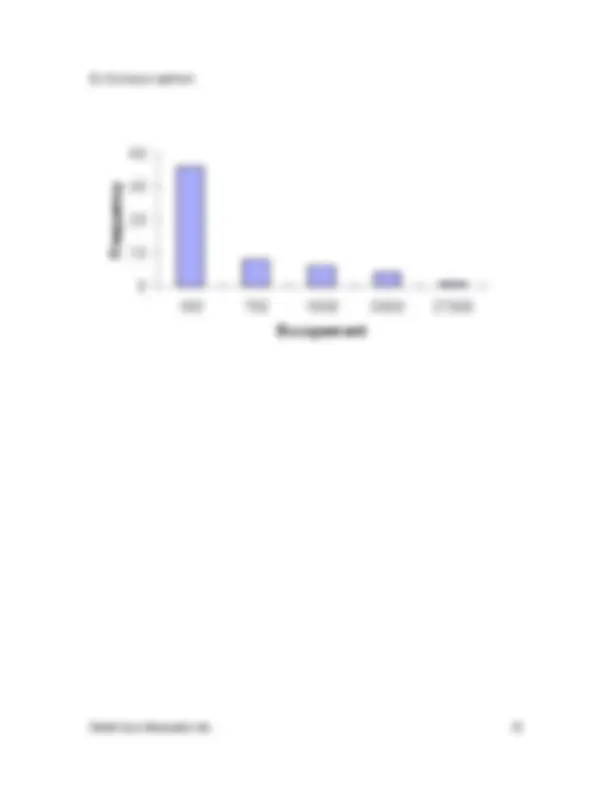
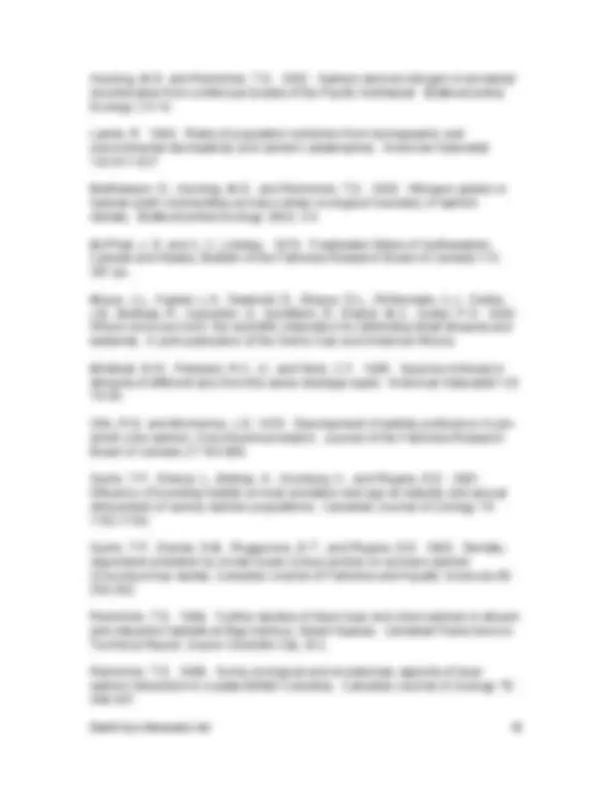
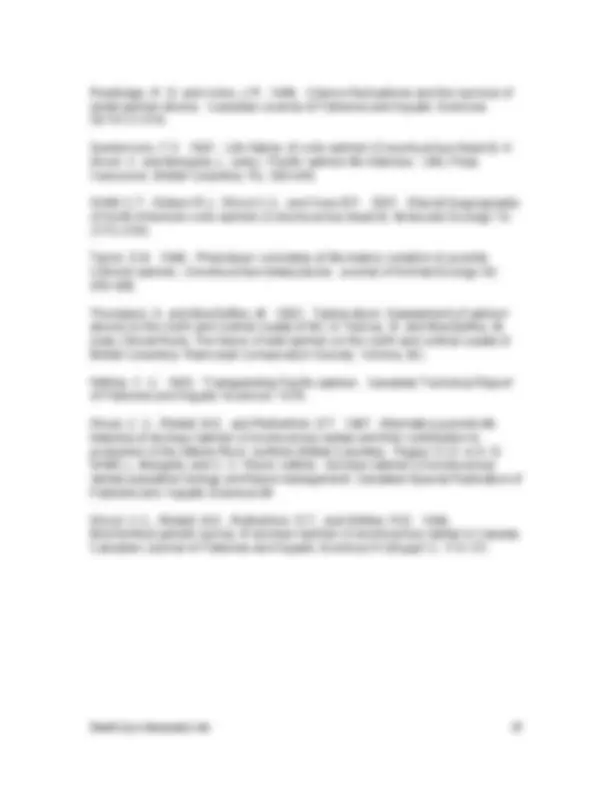


Study with the several resources on Docsity

Earn points by helping other students or get them with a premium plan


Prepare for your exams
Study with the several resources on Docsity

Earn points to download
Earn points by helping other students or get them with a premium plan
Community
Ask the community for help and clear up your study doubts
Discover the best universities in your country according to Docsity users
Free resources
Download our free guides on studying techniques, anxiety management strategies, and thesis advice from Docsity tutors
This document emphasizes the significance of small salmon runs in British Columbia, which are often overlooked in favor of managing larger, more productive rivers. Small streams are vital sources of nutrients and genetic diversity for coastal ecosystems, and their loss can have detrimental effects on salmon populations and the overall health of the ecosystem. The document also discusses the historical importance of small streams to First Nations food fisheries.
Typology: Lecture notes
1 / 19

This page cannot be seen from the preview
Don't miss anything!












Preface
This document has been prepared in response to an increased focus by government on the management and monitoring of large salmon runs at the expense of the health of small salmon runs in coastal British Columbia. This paper will emphasize the role of small salmon runs in the overall structure and genetics of salmon populations in addition to their role in healthy functioning ecosystems; it is not intended to refute the importance of large salmon runs.
Before proceeding, we should define what we mean by the term small stream. The province of British Columbia recognizes nine major systems: the Columbia, Fraser, Liard, Mackenzie, Nass, Peace, Skeena, Stikine and Taku Rivers (see Figure 1 for map of DFO management areas). For the purposes of this report, we recognize everything outside of these rivers as small streams. Unfortunately, this definition is complicated by the fact that there are thousands of small streams in the headwaters of these large watersheds feeding into these rivers. The health of these small rivers is vital to the health of the downstream waterways and has been well documented (see Meyer et al. 2003 for review). However, the focus of this document is on small streams that connect directly with the ocean. These small streams are common among the broken topography of coastal ecosystems, but have received comparatively little attention. Combined, these small streams are habitat for a considerable proportion of the salmon biomass in British Columbia and likely a far greater proportion of salmon genetic diversity.
populations are more vulnerable than larger runs, and are therefore at greater risk of extirpation (Lande 1993; Routledge and Irvine 1999). Loss of small salmon populations is eroding salmon genetic diversity and population structure; this threatens short-term productivity and long-term survival of BC salmon.
Ecological considerations
The importance of salmon in coastal ecosystems has only recently been appreciated and the complexity of these systems is still not fully understood. Over 190 species directly use salmon (Cederholm et al. 2000). Nutrients from consumed salmon are returned to the watershed, particularly through vectors such as bears (Reimchen 1994, 2000; Hilderbrand et al. 1999 a ), enriching the ecosystem and increasing biodiversity. The predictability of this annual influx of nutrients to the terrestrial ecosystem has shaped the ecological strategies of organisms that have co-evolved with wild salmon (Darimont et al. 2003). Many coastal species depend on this annual nutritional surge to meet their dietary protein requirements (Darimont and Reimchen 2002) and measures of fitness (e.g., body size, litter size, population density) are often correlated to the availability of this resource (Hilderbrand et al. 1999 b ).
Small rivers and creeks allow increased access to salmon for many predators. Individual fish have less chance of being captured in wider and deeper waterways as there are more escape opportunities afforded by larger habitats (Quinn et al. 2003), which means that proportionally the predation is less in wider rivers and creeks (Quinn et al. 2001). Small streams also provide feeding opportunities for younger bears and other species that may not be up to the competitive interactions that often occur at high density spawning sites where fishing efforts are maximized. Those predators that do feed at these small systems will then transfer those nutrients into the surrounding watershed.
The penetration of marine derived nitrogen into the watershed is correlated with spawning density, with higher densities translating to greater enrichment of the surrounding ecosystem (Hocking, personal communication; Mathewson et al. 2003). Though smaller streams do not support the same salmon biomass as rivers such as the Taku, Stikine, Skeena or Fraser, they often support high spawning densities. Neekas River, near Bella Bella, has a spawning density of 24,000 salmon/km (Mathewson et al. 2003) and a density of chum approaching 71.63 kg of salmon/m, which is likely the highest density of chum on the BC coast (Hocking, personal communication).
Even small salmon runs enrich the surrounding ecosystem (Cederholm et al.
Smaller systems far outnumber larger systems for all salmon species (Figure 4). Combined, these systems add significantly to the overall productivity of salmon resources on the coast (Table 1). Individually, these systems have unique floral and faunal associations based on the abiotic factors (e.g., topography, exposure, water chemistry) that are characteristic of the specific creek or stream. Each small system is an island of biodiversity, with unique interactions and associations that add to the diversity of coastal ecosystems. Loss of small salmon streams on the coast could have implications that far exceed our current understanding of these interactions and ultimately disentangle this web of biodiversity.
during glacial periods and provides a source for repopulation of habitat made available by receding ice sheets (Wood et al. in prep). A similar variation in life history strategy exists in chinook (stream- and ocean-type) (Taylor, 1990; Healey, 1991) and may have similar consequences during glacial periods. Remnant refugial populations are also likely to have other characteristics essential for long-term survival of the species.
Salmon populations have evolved considerable genetic adaptations since the last ice age in response to local habitat differences in physical and biological parameters. This “local adaptation” allows for high productivity across a range of habitats and accounts for the historically high production of salmon in BC. The hundreds of small salmon runs of BC constitute a huge reservoir of genetic adaptations, any one of which may be key to the survival of salmon through times of environmental change. Since each of these adaptations has taken thousands of years to evolve, individual salmon populations with unique characteristics cannot be replaced once they have been extirpated. Loss of even a single run, no matter how small, can be an irreversible loss of genetic diversity.
Although salmon are recognized for their ability to return to their natal stream to spawn, some fish stray into other river systems and spawn with the resident population. Therefore, salmon runs do not exist in isolation from other salmon populations, but are linked to each other by a complex pattern of dynamic population exchange. This straying between populations is important because it promotes genetic exchange, which prevents inbreeding and bolsters the size of populations that may be experiencing a population down turn. Populations connected through immigration can persist at carrying capacities much lower than those of isolated populations (Hilderbrand 2003). Interdependence of salmon runs established over the past 15,000 years is critical to the health and survival of salmon along the coast. The loss of a single population can catalyze the unraveling of these critical interactions leading to wide population and resilience declines.
Freshwater rearing habitat
Some small systems are not suitable spawning grounds for adult salmon because of substrate type, water volume, or seasonal variations in flow, but they can still be important rearing habitat for juvenile salmon. Compared with larger systems, small creeks are usually more susceptible to fluctuations in temperature and water flow; however, they may offer greater habitat complexity and invertebrate richness (Minshall et al. 1985), which are important factors for young salmon.
Small streams may enhance the productivity of larger neighbouring systems by providing additional rearing habitat for juveniles. Coho are territorial in freshwater rearing habitat and if juveniles are unable to maintain a territory they are often displaced downstream (Sandercock 1991). These fish may make their way back upstream, but they may also migrate out of their natal streams along the shore in the low salinity surface waters to nearby systems to rear (Otto and McInerney 1970). Some individuals have a tendency to migrate to nearby systems despite an abundance of habitat in their natal streams; these fish are called nomads (Sandercock 1991). This variation in life history provides access to more resources for salmon rearing and thus more juvenile coho would survive than the natal stream capacity could support. Preliminary findings from the spring 2004 field season suggest the presence of coho and Chinook nomads in small coastal streams. These streams were previously undocumented for the presence of salmon and while they are not used for spawning, they are being sought out by fry for rearing. Work to further document this activity will continue in fall 2004 and 2005.
Figure 1. DFO management areas of the Pacific Region (Fisheries and Oceans Canada, 2004). Management areas 7 and 8 lie within Heiltsuk Traditional Territory.
Figure 2. Spatial distribution of chum salmon streams in Heiltsuk Traditional Territory. Legend values represent mean escapement from 1985-1994.
Figure 4. Frequency distribution of salmon streams in Heiltsuk Traditional Territory based on mean escapement from 1985-1994.
A) Chum salmon
0
10
20
30
40
50
60
70
80
2300 7368 20000 75000 160000 Escapement
Frequency
B) Pink salmon
0
20
40
60
80
9300 30000 67000 150000 3000000 Escapement
Frequency
C) Coho salmon
0
10
20
30
40
50
60
70
200 572 1300 2500 5000 Escapement
Frequency
D) Chinook salmon
0
2
4
6
8
10
100 400 4000 Escapement
Frequency
Table 1. The total escapements (all species combined) for all the small rivers combined in DFO management areas 6 and 7 compared with the escapements for the Skeena river illustrate that the combination of these small salmon runs has a significant contribution to the overall biomass of salmon in British Columbia. Declining escapements over time may be a reflection of reduced effort in stock assessment and/or decreased salmon returns.
Year Area 6 & Area 7 combined escapements
Skeena River escapements (Area 4) 1954 1,264,975 1,229, 1964 2,626,484 2,337, 1974 1,149,225 1,175, 1984 1,142,473 2,208, 1994 833,508 1,333,
References
Cederholm, C.J., Johnson, D.H., Bilby, R.E., Dominguez, L.G., Garrett, A.M., Graeber, W.H., Greda, E.L., Kunze, M.D., Marcot, B.G., Palmisano, J.F., Plotnikoff, R.W., Pearcy, W.G., Simenstad, C.A., and Trotter, P.C. 2000. Pacific salmon and wildlife – ecological contexts, relationships and implications for management. Special Edition Technical Report, Prepared for D.H. Johnson and T. A. O’Neil (Managing directors), Wildlife-habitat relationships in Oregon and Washington. Washington Department of Fish and Wildlife, Olympia, Washington.
Darimont, C.T., and Reimchen, T.E. 2002. Intra-hair stable isotope analysis implies seasonal shift to salmon in gray wolf diet. Canadian Journal of Zoology 80: 1638-1642.
Darimont, C.T., Reimchen, T.E., and Paquet, P.C. 2003. Foraging behaviour by gray wolves on salmon streams in coastal British Columbia. Canadian Journal of Zoology 81:349-353.
Darimont, C.T., Price, M.H.H., Winchester, N.N., Gordon-Walker, J., and Paquet, P.C. 2004. Predators in natural fragments: foraging ecology of wolves in British Columbia’s central and north coast archipelago (in preparation).
Fisheries and Oceans Canada. 2004. Management Areas – Pacific Region. http://www.pac.dfo-mpo.gc.ca/ops/fm/Areas/areamap_e.htm. Date accessed: June 10, 2004.
Healey, M.C. 1991. Life history of Chinook salmon ( Oncorhynchus tshawytscha ) In Groot, C. and Margolis, L. (eds.) Pacific salmon life histories. UBC Press. Vancouver, British Columbia. Pp. 311-
Hilderbrand, G.V., Hanley, T.A., Robbins, C.T., and Schwartz, C.C. 1999 a. Role of brown bears ( Ursus arctos ) in the flow of marine nitrogen into a terrestrial ecosystem. Oecologia 21: 546-550.
Hilderbrand, G.V., Schwartz, C.C., Robbins, C.T., Jacoby, M.E., Hanley, T.A., Arthur, S.M., and Serveheen, C. 1999 b. Importance of meat, particularly salmon, to body size, population productivity, and conservation of North American brown bears. Canadian Journal of Zoology 77: 132-138.
Hilderbrand, R.H. 2003. The roles of carrying capacity, immigration, and population synchrony on persistence of stream-resident cutthroat trout. Biological Conservation 110: 257-266.
Hocking, M.D., Ph.D. candidate, University of Victoria, Victoria, British Columbia. Personal communication, May 11, 2004.
Routledge, R. D. and Irvine, J.R. 1999. Chance fluctuations and the survival of small salmon stocks. Canadian Journal of Fisheries and Aquatic Sciences 56:1512-1519.
Sandercock, F.K. 1991. Life history of coho salmon ( Oncorhynchus kisutch ) In Groot, C. and Margolis, L. (eds.). Pacific salmon life histories. UBC Pess. Vancouver, British Columbia. Pp. 395-446.
Smith C.T., Nelson R.J., Wood C.C., and Koop B.F. 2001. Glacial biogeography of North American coho salmon ( Oncorhynchus kisutch ). Molecular Ecology 10, 2775-2785.
Taylor, E.B. 1990. Phenotypic correlates of life-history variation in juvenile Chinook salmon, Oncorhynchus tshawytscha. Journal of Animal Ecology 59: 455-468.
Thompson, S. and MacDuffee, M. 2002. Taking stock: Assessment of salmon stocks on the north and central coasts of BC In Harvey, B. and MacDuffee, M. (eds.) Ghost Runs: The future of wild salmon on the north and central coasts of British Columbia. Raincoast Conservation Society. Victoria, BC.
Withler, F. C. 1982. Transplanting Pacific salmon. Canadian Technical Report of Fisheries and Aquatic Sciences 1079.
Wood, C. C., Riddell, B.E., and Rutherford, D.T. 1987. Alternative juvenile life histories of sockeye salmon ( Oncorhynchus nerka ) and their contribution to production in the Stikine River, northern British Columbia. Pages 12-21 in H. D. Smith, L. Margolis, and C. C. Wood, editors. Sockeye salmon ( Oncorhynchus nerka ) population biology and future management. Canadian Special Publication of Fisheries and Aquatic Sciences 96
Wood, C.C., Riddell, B.E., Rutherford, D.T., and Withler, R.E. 1994. Biochemical genetic survey of sockeye salmon ( Oncorhynchus nerka ) in Canada. Canadian Journal of Fisheries and Aquatic Sciences 51 ( Suppl.1): 114-131.